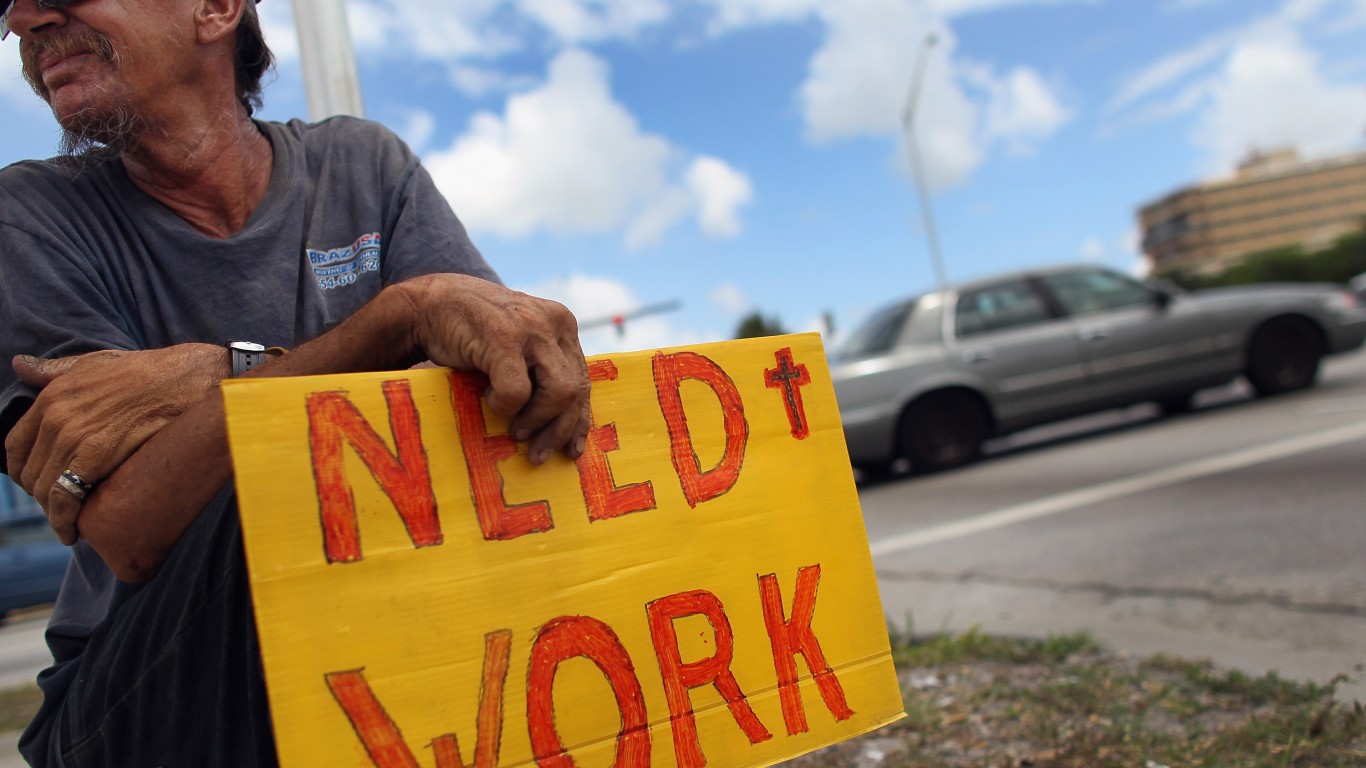
The COVID-19 pandemic set off an economic crisis that pushed the unemployment rate to levels that rivaled the highs of the Great Depression. Fortunately, the recovery has been relatively rapid, and weekly initial unemployment claims in the United States have been below half a million since early May 2021. The last time they were below that threshold was in March 2020, when President Donald Trump declared COVID-19 a national emergency.
Whether the result of a pandemic or not, unemployment is never desirable. However, in some states, conditions are more favorable for those who are out of work than in others. The current condition of the labor market; its recovery course since the pandemic hit; and the strength of the social safety net are all factors that vary from state to state.
Using data from the U.S. Department of Labor, 24/7 Wall St. created an index of four measures — unemployment benefit recipiency, average weekly unemployment payments as a share of average wages, one-year employment growth, and the April unemployment rate — to determine the best and worst states to be unemployed. States are ranked from best to worst.
To ease the financial hardship for the millions of Americans who found themselves out of work during the pandemic, the federal government improved unemployment benefits — expanding eligibility and increasing payments. As the economy recovers, some parts of the country have revoked those extended benefits. It is important to note that the average weekly unemployment benefit payouts by state used in this story does not include the supplemental federal payments added during the pandemic. Here is a look at the 39 states where people gave up looking for work during the pandemic.
The expanded eligibility for unemployment benefits during the pandemic raised recipiency rates in every state year over year. Also perhaps due to eligibility expansion, in a handful of states, the average number of people who received unemployment insurance benefits in 2020 even exceeded the average number of people who were unemployed over the course of the year. Here is a look at the American cities that added jobs during the pandemic.
Click here to see the best and worst states to be unemployed.
Click here to see our detailed methodology.

1. Vermont
> Unemployed population receiving benefits: 134.5% (the highest)
> Avg. weekly unemployment benefit: $428 (58.0% of avg. wage — the highest)
> 1-yr. employment growth: +0.7% (2nd lowest)
> April 2021 unemployment rate: 2.9% (5th lowest)
[in-text-ad]

2. Georgia
> Unemployed population receiving benefits: 120.9% (2nd highest)
> Avg. weekly unemployment benefit: $262 (39.9% of avg. wage — 23rd lowest)
> 1-yr. employment growth: +13.4% (17th highest)
> April 2021 unemployment rate: 4.3% (17th lowest)

3. Minnesota
> Unemployed population receiving benefits: 107.8% (3rd highest)
> Avg. weekly unemployment benefit: $387 (46.0% of avg. wage — 11th highest)
> 1-yr. employment growth: +5.8% (10th lowest)
> April 2021 unemployment rate: 4.1% (14th lowest)

4. Iowa
> Unemployed population receiving benefits: 91.3% (11th highest)
> Avg. weekly unemployment benefit: $367 (48.7% of avg. wage — 5th highest)
> 1-yr. employment growth: +3.7% (8th lowest)
> April 2021 unemployment rate: 3.8% (10th lowest)
[in-text-ad-2]

5. Maine
> Unemployed population receiving benefits: 107.0% (4th highest)
> Avg. weekly unemployment benefit: $323 (43.9% of avg. wage — 20th highest)
> 1-yr. employment growth: +7.9% (15th lowest)
> April 2021 unemployment rate: 4.8% (23rd lowest)

6. Oklahoma
> Unemployed population receiving benefits: 71.6% (25th lowest)
> Avg. weekly unemployment benefit: $348 (49.3% of avg. wage — 4th highest)
> 1-yr. employment growth: +12.8% (21st highest)
> April 2021 unemployment rate: 4.3% (17th lowest)
[in-text-ad]
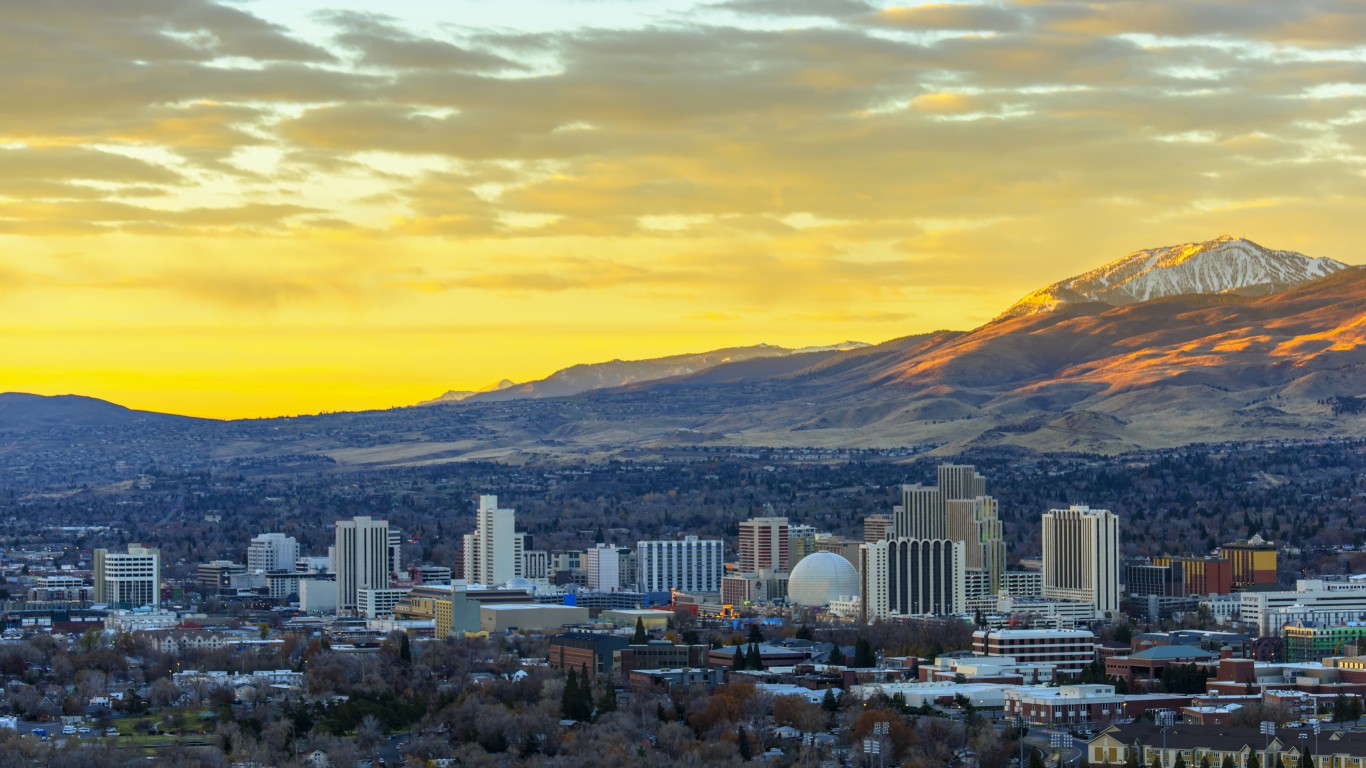
7. Nevada
> Unemployed population receiving benefits: 87.9% (12th highest)
> Avg. weekly unemployment benefit: $372 (45.5% of avg. wage — 14th highest)
> 1-yr. employment growth: +35.9% (the highest)
> April 2021 unemployment rate: 8.0% (6th highest)

8. New Hampshire
> Unemployed population receiving benefits: 66.2% (17th lowest)
> Avg. weekly unemployment benefit: $274 (36.2% of avg. wage — 14th lowest)
> 1-yr. employment growth: +19.2% (6th highest)
> April 2021 unemployment rate: 2.8% (4th lowest)
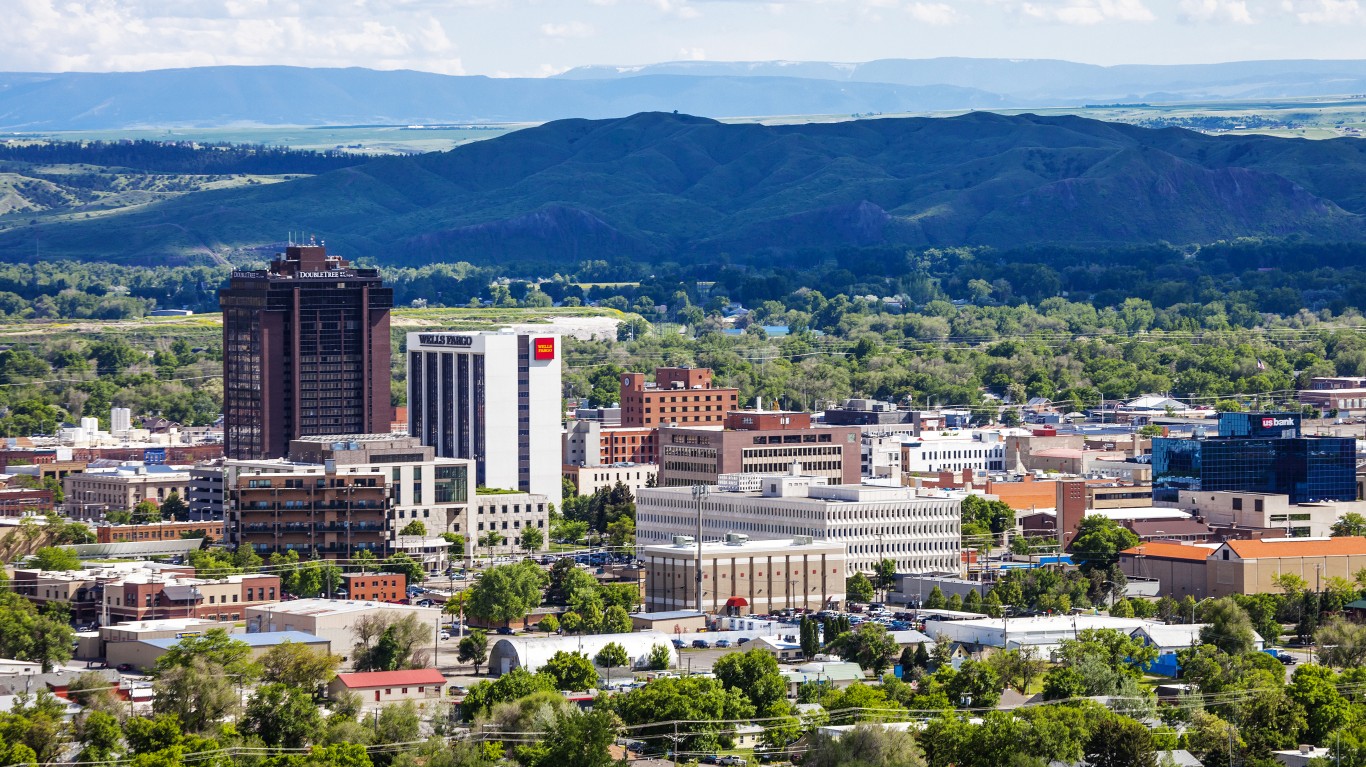
9. Montana
> Unemployed population receiving benefits: 80.8% (16th highest)
> Avg. weekly unemployment benefit: $322 (46.7% of avg. wage — 8th highest)
> 1-yr. employment growth: +7.1% (11th lowest)
> April 2021 unemployment rate: 3.7% (9th lowest)
[in-text-ad-2]

10. Michigan
> Unemployed population receiving benefits: 79.6% (18th highest)
> Avg. weekly unemployment benefit: $308 (36.5% of avg. wage — 15th lowest)
> 1-yr. employment growth: +27.6% (2nd highest)
> April 2021 unemployment rate: 4.9% (24th lowest)

11. Massachusetts
> Unemployed population receiving benefits: 96.2% (7th highest)
> Avg. weekly unemployment benefit: $409 (43.3% of avg. wage — 21st highest)
> 1-yr. employment growth: +22.9% (3rd highest)
> April 2021 unemployment rate: 6.5% (14th highest)
[in-text-ad]

12. Kansas
> Unemployed population receiving benefits: 67.3% (20th lowest)
> Avg. weekly unemployment benefit: $375 (42.5% of avg. wage — 24th highest)
> 1-yr. employment growth: +12.1% (25th highest)
> April 2021 unemployment rate: 3.5% (7th lowest)

13. North Dakota
> Unemployed population receiving benefits: 76.6% (22nd highest)
> Avg. weekly unemployment benefit: $444 (50.3% of avg. wage — 3rd highest)
> 1-yr. employment growth: +3.1% (6th lowest)
> April 2021 unemployment rate: 4.2% (15th lowest)

14. Utah
> Unemployed population receiving benefits: 55.8% (7th lowest)
> Avg. weekly unemployment benefit: $387 (44.5% of avg. wage — 17th highest)
> 1-yr. employment growth: +9.0% (18th lowest)
> April 2021 unemployment rate: 2.8% (4th lowest)
[in-text-ad-2]
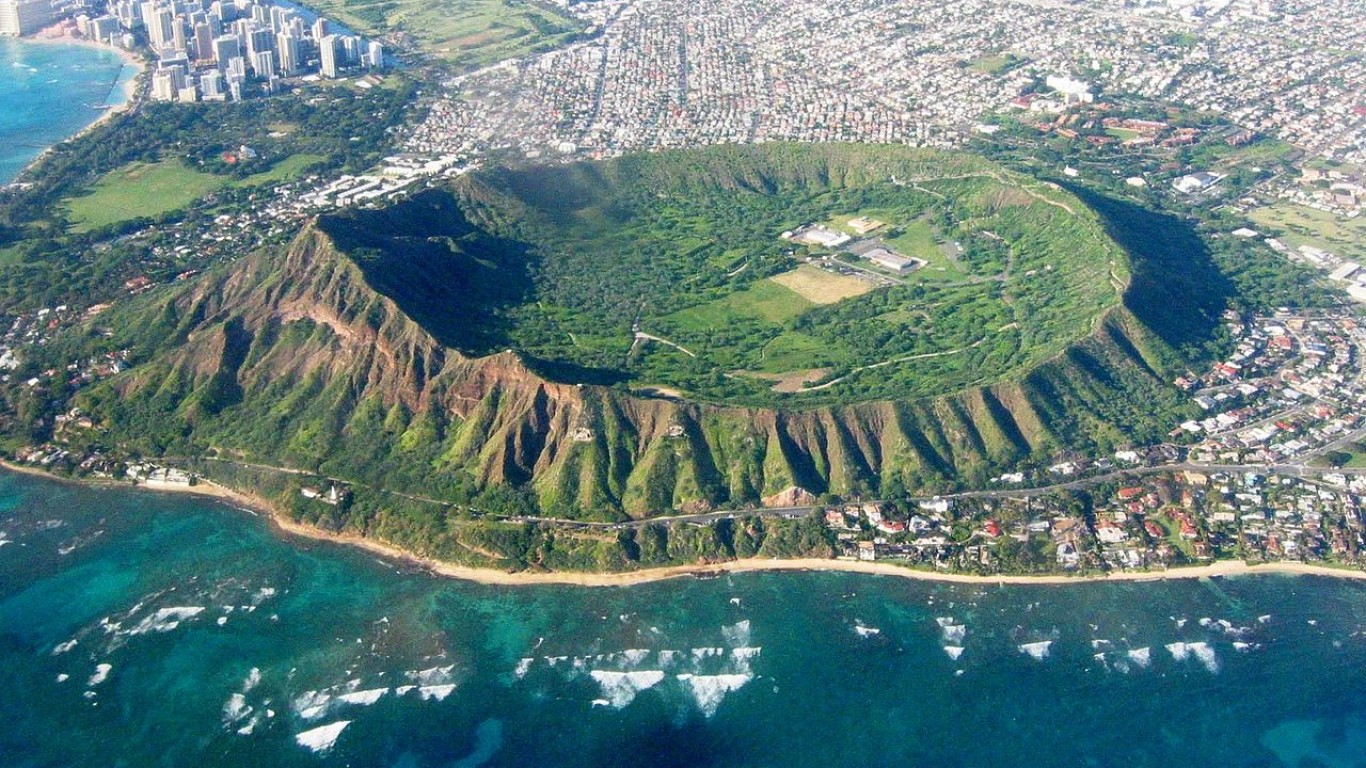
15. Hawaii
> Unemployed population receiving benefits: 95.9% (8th highest)
> Avg. weekly unemployment benefit: $455 (55.0% of avg. wage — 2nd highest)
> 1-yr. employment growth: +19.4% (5th highest)
> April 2021 unemployment rate: 8.5% (the highest)

16. Idaho
> Unemployed population receiving benefits: 47.6% (5th lowest)
> Avg. weekly unemployment benefit: $320 (45.8% of avg. wage — 13th highest)
> 1-yr. employment growth: +12.5% (22nd highest)
> April 2021 unemployment rate: 3.1% (6th lowest)
[in-text-ad]

17. Wisconsin
> Unemployed population receiving benefits: 76.8% (21st highest)
> Avg. weekly unemployment benefit: $306 (37.4% of avg. wage — 19th lowest)
> 1-yr. employment growth: +13.3% (19th highest)
> April 2021 unemployment rate: 3.9% (12th lowest)
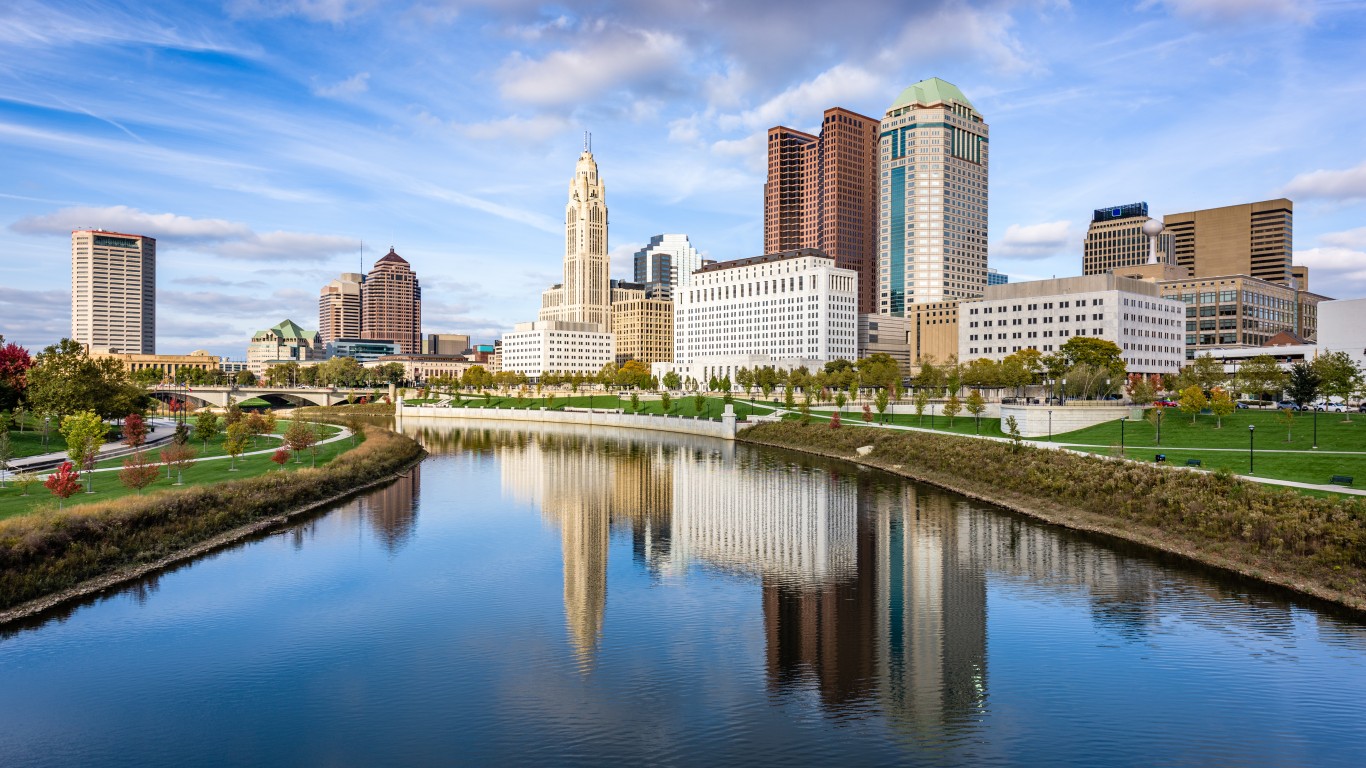
18. Ohio
> Unemployed population receiving benefits: 61.1% (12th lowest)
> Avg. weekly unemployment benefit: $330 (43.3% of avg. wage — 21st highest)
> 1-yr. employment growth: +18.6% (7th highest)
> April 2021 unemployment rate: 4.7% (21st lowest)
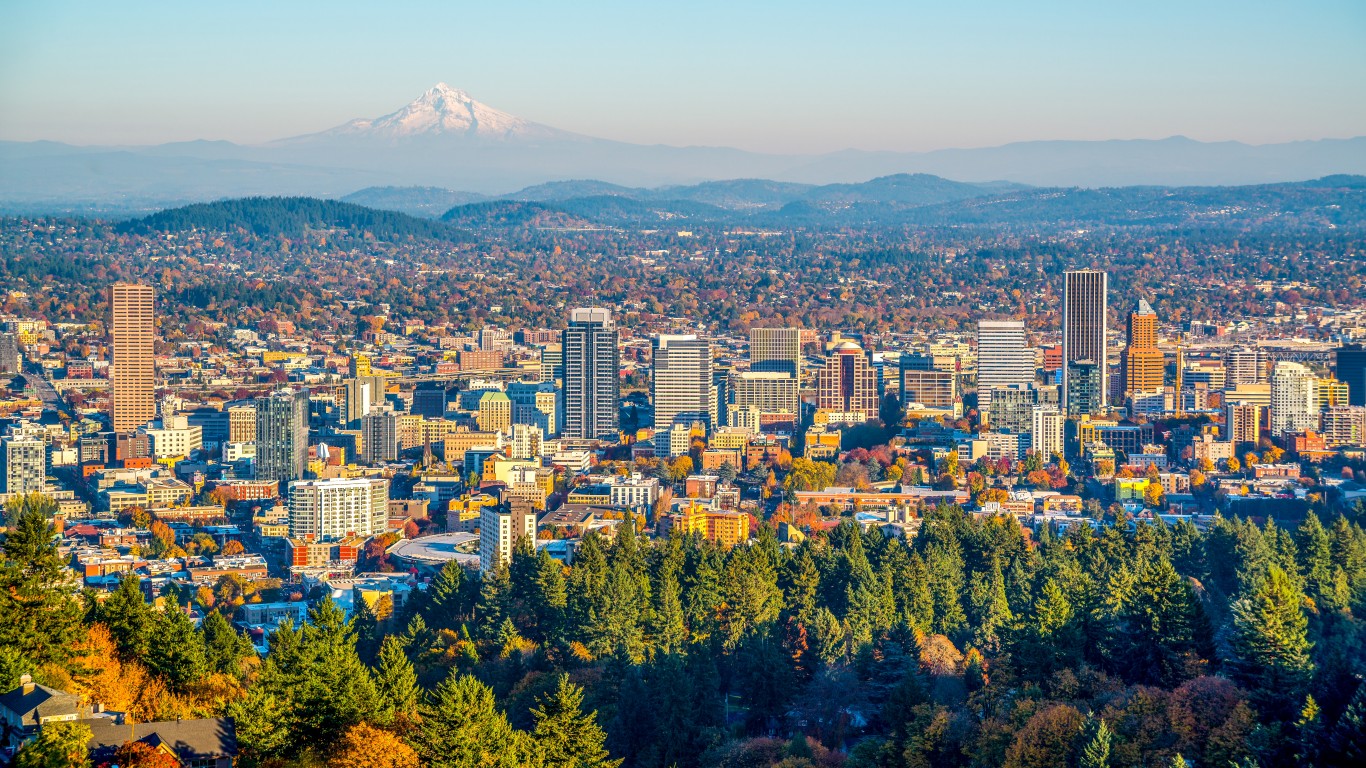
19. Oregon
> Unemployed population receiving benefits: 84.0% (15th highest)
> Avg. weekly unemployment benefit: $368 (45.9% of avg. wage — 12th highest)
> 1-yr. employment growth: +14.3% (14th highest)
> April 2021 unemployment rate: 6.0% (20th highest)
[in-text-ad-2]

20. Nebraska
> Unemployed population receiving benefits: 61.3% (13th lowest)
> Avg. weekly unemployment benefit: $305 (45.0% of avg. wage — 15th highest)
> 1-yr. employment growth: +1.7% (3rd lowest)
> April 2021 unemployment rate: 2.8% (4th lowest)
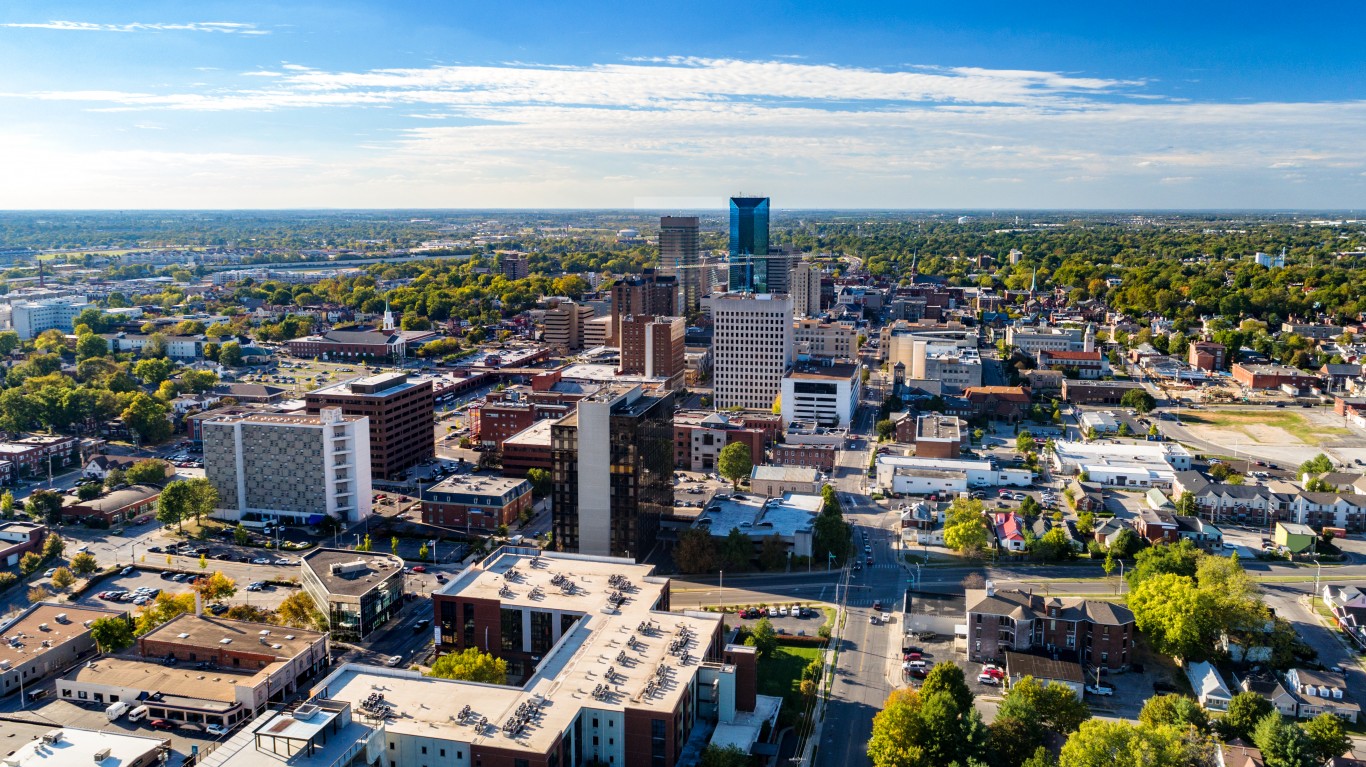
21. Kentucky
> Unemployed population receiving benefits: 78.0% (20th highest)
> Avg. weekly unemployment benefit: $306 (42.9% of avg. wage — 23rd highest)
> 1-yr. employment growth: +9.3% (19th lowest)
> April 2021 unemployment rate: 4.7% (21st lowest)
[in-text-ad]
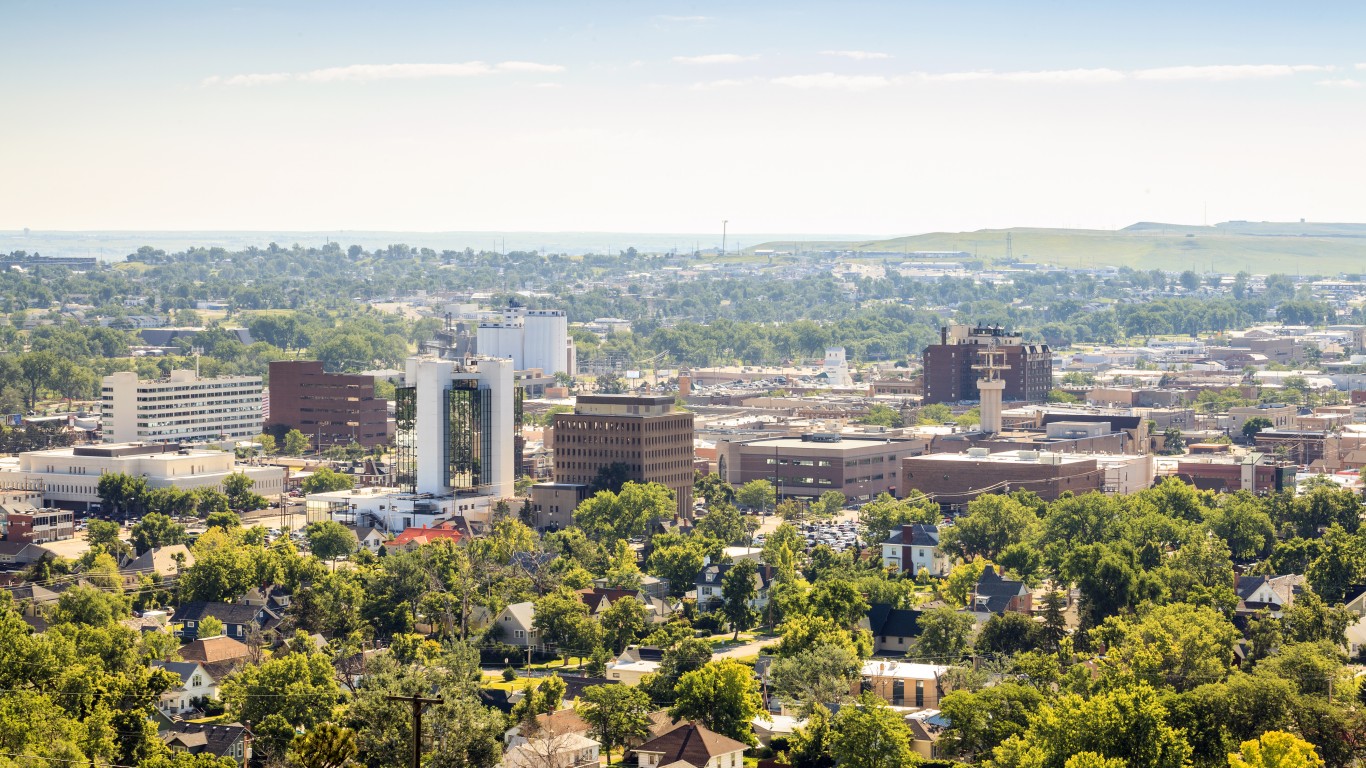
22. South Dakota
> Unemployed population receiving benefits: 42.4% (the lowest)
> Avg. weekly unemployment benefit: $322 (46.3% of avg. wage — 10th highest)
> 1-yr. employment growth: +7.2% (13th lowest)
> April 2021 unemployment rate: 2.8% (4th lowest)

23. Indiana
> Unemployed population receiving benefits: 63.5% (16th lowest)
> Avg. weekly unemployment benefit: $236 (32.7% of avg. wage — 6th lowest)
> 1-yr. employment growth: +19.6% (4th highest)
> April 2021 unemployment rate: 3.9% (12th lowest)

24. Alabama
> Unemployed population receiving benefits: 56.4% (8th lowest)
> Avg. weekly unemployment benefit: $242 (38.6% of avg. wage — 22nd lowest)
> 1-yr. employment growth: +13.4% (18th highest)
> April 2021 unemployment rate: 3.6% (8th lowest)
[in-text-ad-2]

25. Washington
> Unemployed population receiving benefits: 74.1% (23rd highest)
> Avg. weekly unemployment benefit: $488 (44.4% of avg. wage — 18th highest)
> 1-yr. employment growth: +9.5% (20th lowest)
> April 2021 unemployment rate: 5.5% (22nd highest)

26. Pennsylvania
> Unemployed population receiving benefits: 86.6% (14th highest)
> Avg. weekly unemployment benefit: $352 (46.5% of avg. wage — 9th highest)
> 1-yr. employment growth: +11.0% (23rd lowest)
> April 2021 unemployment rate: 7.4% (8th highest)
[in-text-ad]

27. Missouri
> Unemployed population receiving benefits: 58.7% (10th lowest)
> Avg. weekly unemployment benefit: $245 (34.8% of avg. wage — 12th lowest)
> 1-yr. employment growth: +12.9% (20th highest)
> April 2021 unemployment rate: 4.1% (14th lowest)

28. Rhode Island
> Unemployed population receiving benefits: 79.3% (19th highest)
> Avg. weekly unemployment benefit: $327 (40.9% of avg. wage — 24th lowest)
> 1-yr. employment growth: +12.1% (24th highest)
> April 2021 unemployment rate: 6.3% (17th highest)

29. South Carolina
> Unemployed population receiving benefits: 73.1% (24th highest)
> Avg. weekly unemployment benefit: $246 (38.4% of avg. wage — 21st lowest)
> 1-yr. employment growth: +8.5% (17th lowest)
> April 2021 unemployment rate: 5.0% (24th highest)
[in-text-ad-2]
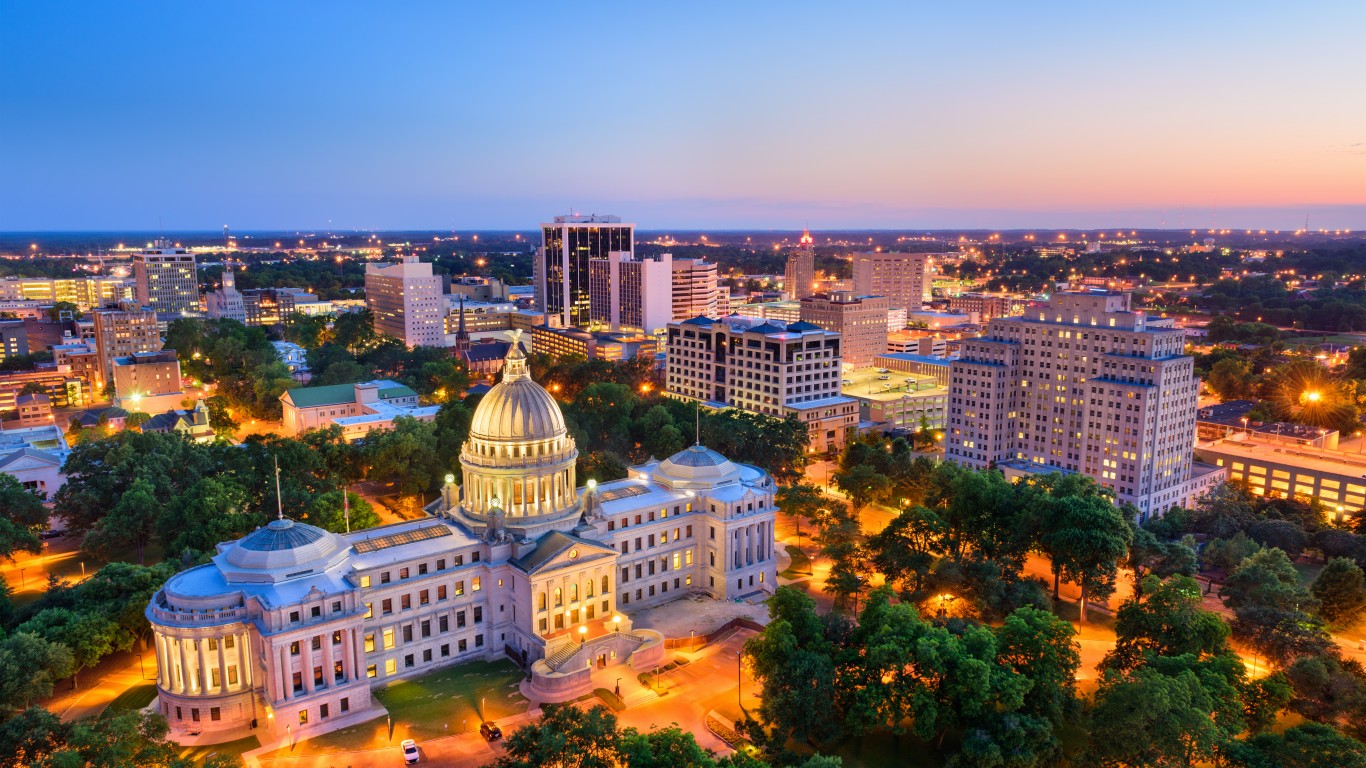
30. Mississippi
> Unemployed population receiving benefits: 79.8% (17th highest)
> Avg. weekly unemployment benefit: $187 (34.9% of avg. wage — 13th lowest)
> 1-yr. employment growth: +17.0% (11th highest)
> April 2021 unemployment rate: 6.2% (18th highest)

31. West Virginia
> Unemployed population receiving benefits: 68.7% (21st lowest)
> Avg. weekly unemployment benefit: $272 (36.6% of avg. wage — 16th lowest)
> 1-yr. employment growth: +15.6% (13th highest)
> April 2021 unemployment rate: 5.8% (21st highest)
[in-text-ad]
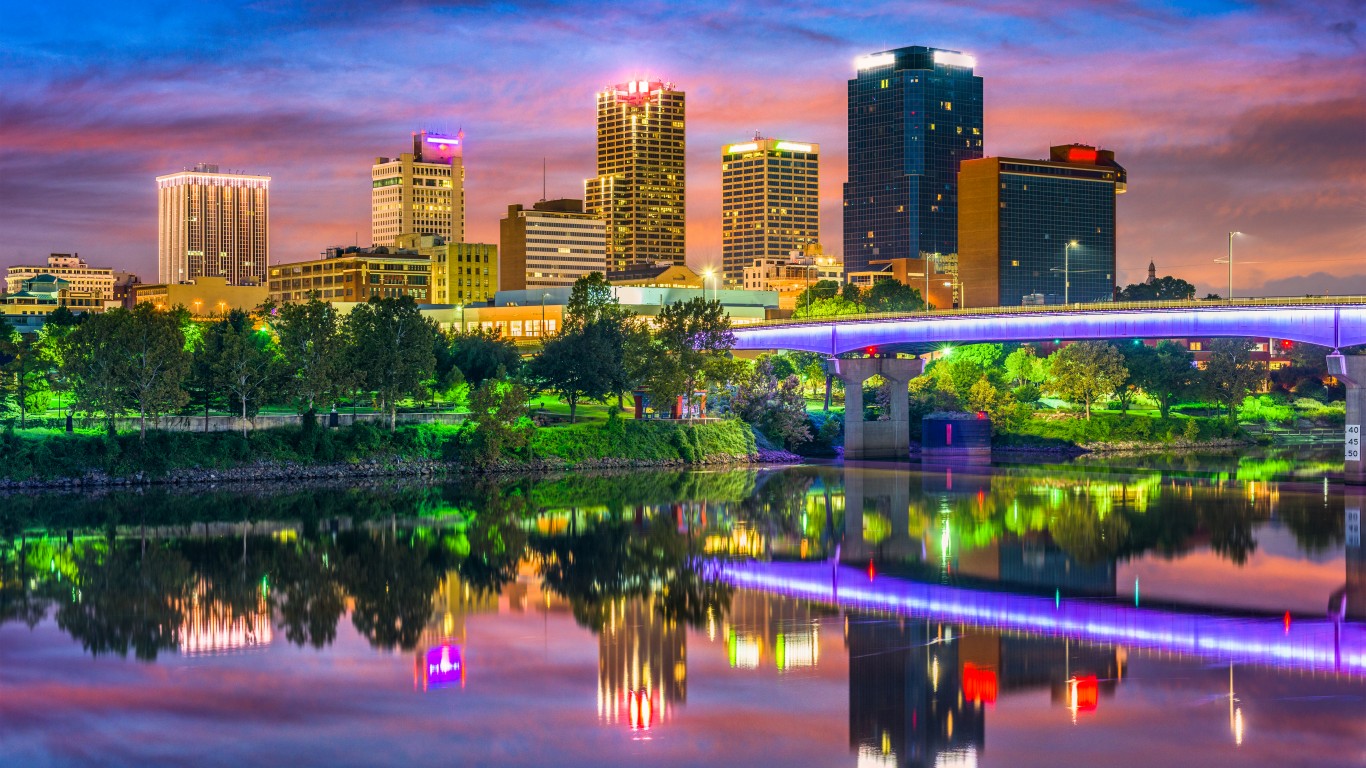
32. Arkansas
> Unemployed population receiving benefits: 63.0% (14th lowest)
> Avg. weekly unemployment benefit: $242 (37.8% of avg. wage — 20th lowest)
> 1-yr. employment growth: +5.5% (9th lowest)
> April 2021 unemployment rate: 4.4% (18th lowest)

33. Tennessee
> Unemployed population receiving benefits: 56.6% (9th lowest)
> Avg. weekly unemployment benefit: $218 (32.7% of avg. wage — 6th lowest)
> 1-yr. employment growth: +17.9% (8th highest)
> April 2021 unemployment rate: 5.0% (24th highest)

34. New York
> Unemployed population receiving benefits: 104.1% (5th highest)
> Avg. weekly unemployment benefit: $344 (33.9% of avg. wage — 7th lowest)
> 1-yr. employment growth: +17.4% (10th highest)
> April 2021 unemployment rate: 8.2% (3rd highest)
[in-text-ad-2]

35. Texas
> Unemployed population receiving benefits: 66.5% (19th lowest)
> Avg. weekly unemployment benefit: $371 (42.5% of avg. wage — 24th highest)
> 1-yr. employment growth: +12.4% (23rd highest)
> April 2021 unemployment rate: 6.7% (11th highest)

36. New Jersey
> Unemployed population receiving benefits: 71.6% (24th lowest)
> Avg. weekly unemployment benefit: $409 (48.0% of avg. wage — 6th highest)
> 1-yr. employment growth: +9.5% (21st lowest)
> April 2021 unemployment rate: 7.5% (7th highest)
[in-text-ad]
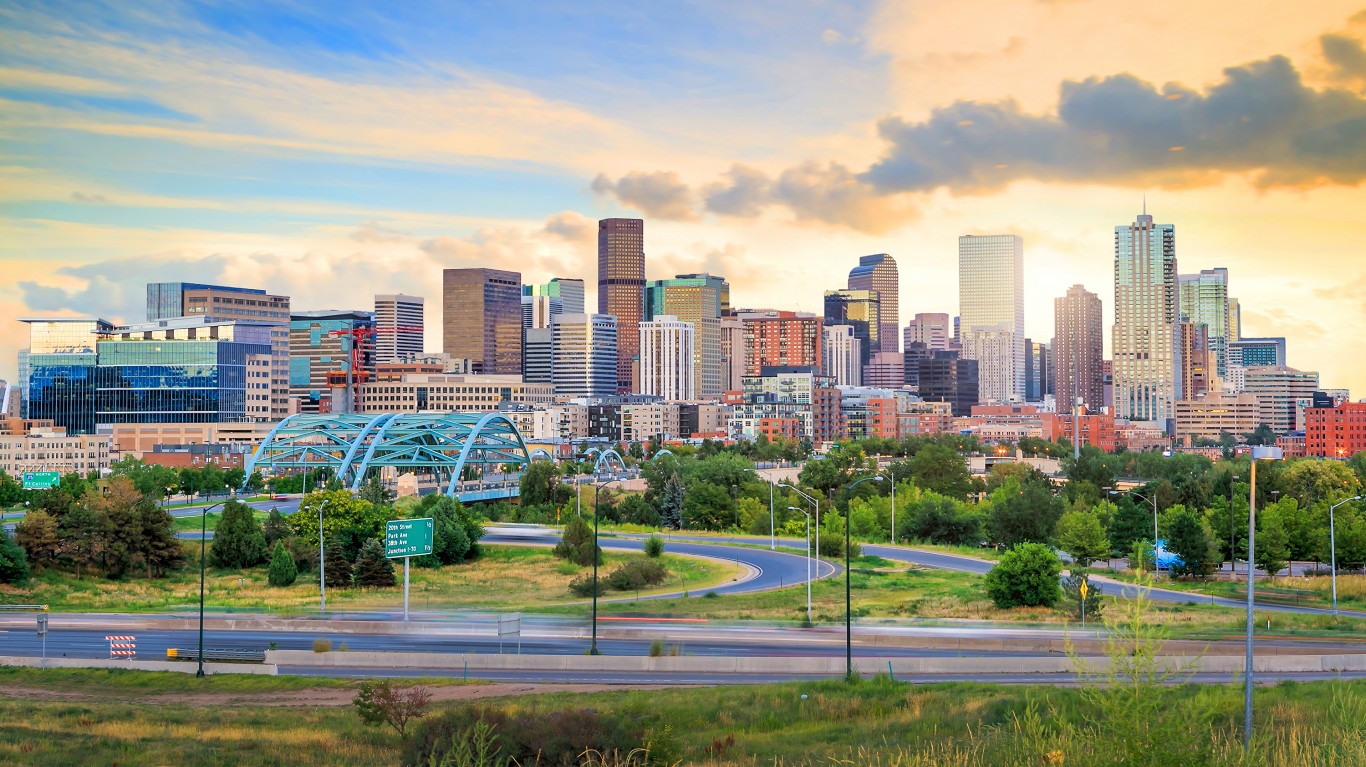
37. Colorado
> Unemployed population receiving benefits: 59.9% (11th lowest)
> Avg. weekly unemployment benefit: $402 (41.6% of avg. wage — 25th lowest)
> 1-yr. employment growth: +14.2% (15th highest)
> April 2021 unemployment rate: 6.4% (15th highest)
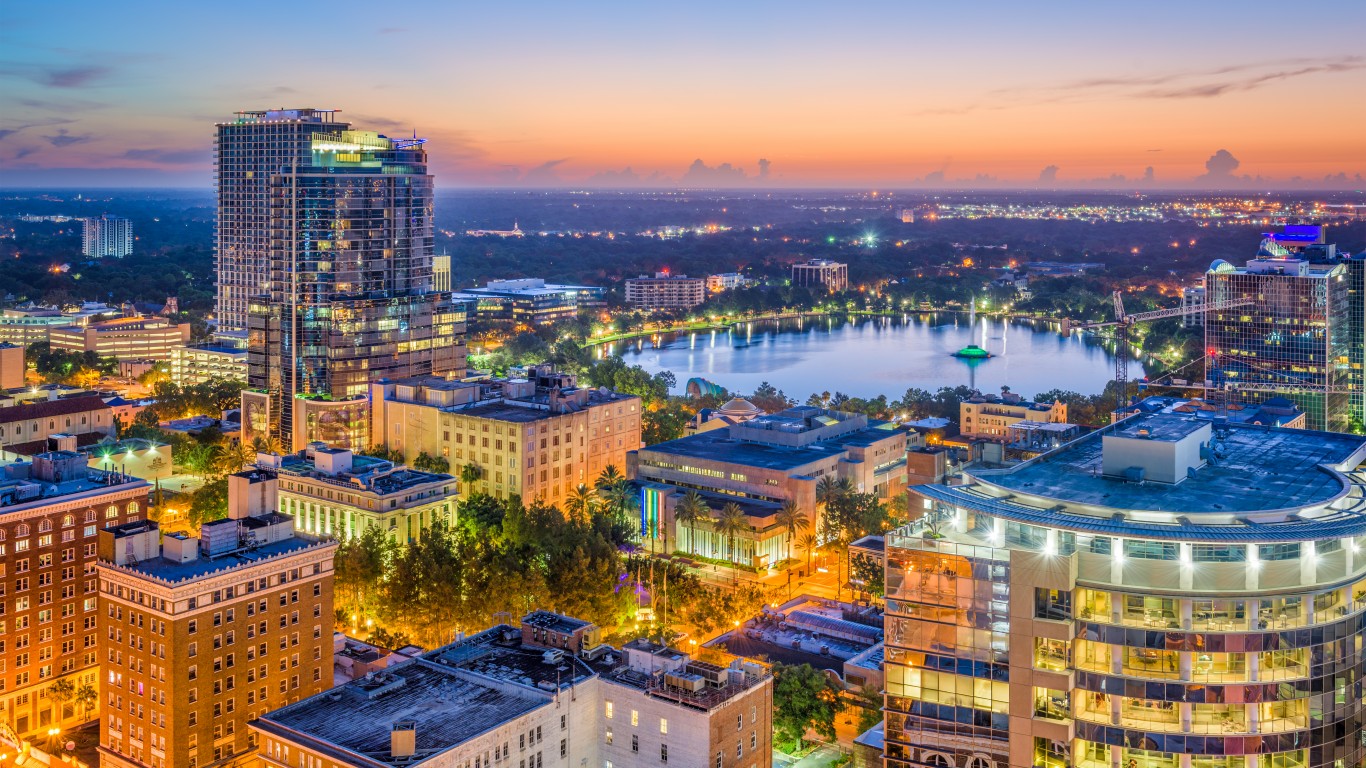
38. Florida
> Unemployed population receiving benefits: 44.9% (3rd lowest)
> Avg. weekly unemployment benefit: $234 (34.2% of avg. wage — 9th lowest)
> 1-yr. employment growth: +16.1% (12th highest)
> April 2021 unemployment rate: 4.8% (23rd lowest)

39. Virginia
> Unemployed population receiving benefits: 69.8% (23rd lowest)
> Avg. weekly unemployment benefit: $277 (34.6% of avg. wage — 11th lowest)
> 1-yr. employment growth: +3.4% (7th lowest)
> April 2021 unemployment rate: 4.7% (21st lowest)
[in-text-ad-2]

40. Delaware
> Unemployed population receiving benefits: 69.7% (22nd lowest)
> Avg. weekly unemployment benefit: $251 (37.1% of avg. wage — 18th lowest)
> 1-yr. employment growth: +11.5% (25th lowest)
> April 2021 unemployment rate: 6.4% (15th highest)
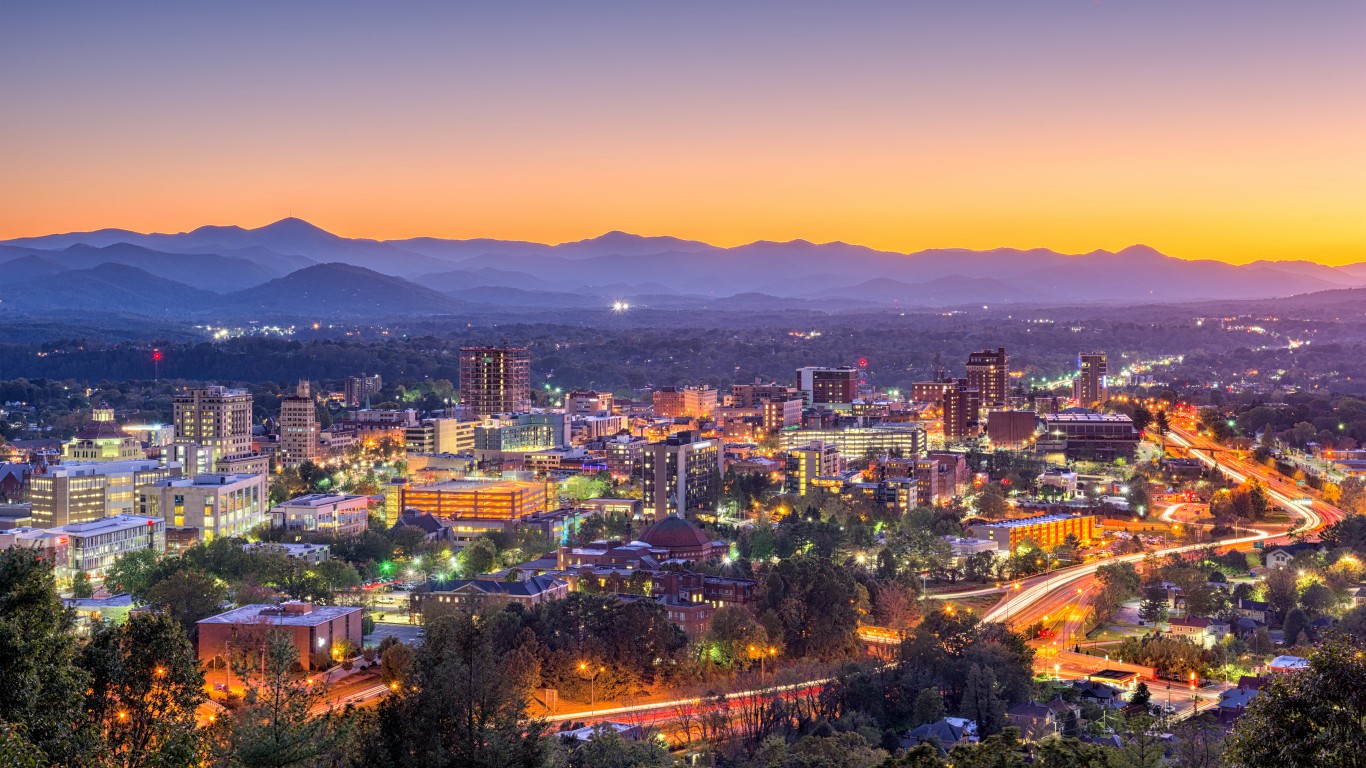
41. North Carolina
> Unemployed population receiving benefits: 44.0% (2nd lowest)
> Avg. weekly unemployment benefit: $234 (32.1% of avg. wage — 4th lowest)
> 1-yr. employment growth: +17.4% (9th highest)
> April 2021 unemployment rate: 5.0% (24th highest)
[in-text-ad]

42. Maryland
> Unemployed population receiving benefits: 63.1% (15th lowest)
> Avg. weekly unemployment benefit: $320 (44.3% of avg. wage — 19th highest)
> 1-yr. employment growth: +2.6% (5th lowest)
> April 2021 unemployment rate: 6.2% (18th highest)

43. Wyoming
> Unemployed population receiving benefits: 50.3% (6th lowest)
> Avg. weekly unemployment benefit: $418 (44.7% of avg. wage — 16th highest)
> 1-yr. employment growth: +1.9% (4th lowest)
> April 2021 unemployment rate: 5.4% (23rd highest)

44. New Mexico
> Unemployed population receiving benefits: 72.0% (25th highest)
> Avg. weekly unemployment benefit: $318 (47.5% of avg. wage — 7th highest)
> 1-yr. employment growth: +7.2% (12th lowest)
> April 2021 unemployment rate: 8.2% (3rd highest)
[in-text-ad-2]
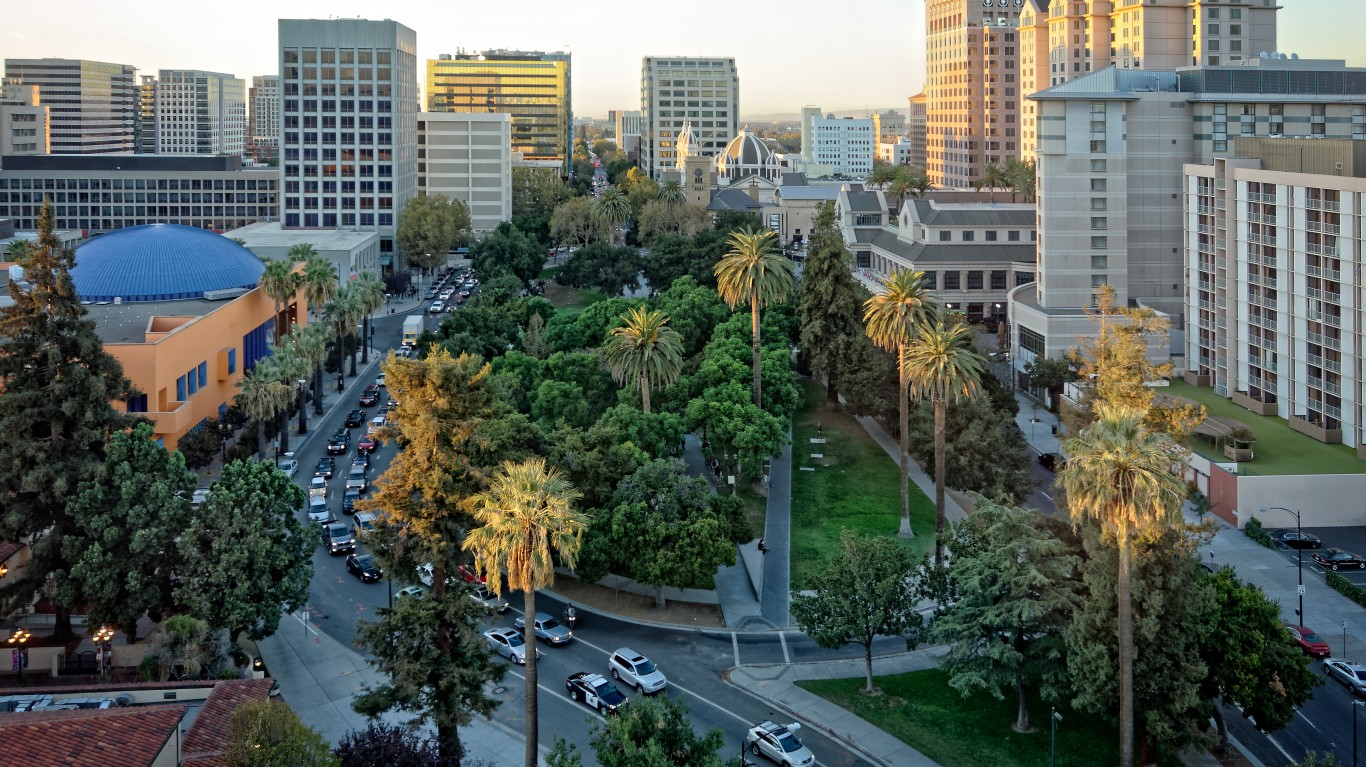
45. California
> Unemployed population receiving benefits: 95.6% (9th highest)
> Avg. weekly unemployment benefit: $308 (34.3% of avg. wage — 10th lowest)
> 1-yr. employment growth: +11.2% (24th lowest)
> April 2021 unemployment rate: 8.3% (2nd highest)

46. Illinois
> Unemployed population receiving benefits: 66.4% (18th lowest)
> Avg. weekly unemployment benefit: $304 (34.0% of avg. wage — 8th lowest)
> 1-yr. employment growth: +13.5% (16th highest)
> April 2021 unemployment rate: 7.1% (10th highest)
[in-text-ad]

47. Alaska
> Unemployed population receiving benefits: 87.6% (13th highest)
> Avg. weekly unemployment benefit: $252 (26.8% of avg. wage — 2nd lowest)
> 1-yr. employment growth: +7.4% (14th lowest)
> April 2021 unemployment rate: 6.7% (11th highest)

48. Louisiana
> Unemployed population receiving benefits: 94.6% (10th highest)
> Avg. weekly unemployment benefit: $188 (23.1% of avg. wage — the lowest)
> 1-yr. employment growth: +8.3% (16th lowest)
> April 2021 unemployment rate: 7.3% (9th highest)

49. Connecticut
> Unemployed population receiving benefits: 98.7% (6th highest)
> Avg. weekly unemployment benefit: $312 (37.0% of avg. wage — 17th lowest)
> 1-yr. employment growth: -4.1% (the lowest)
> April 2021 unemployment rate: 8.1% (5th highest)
[in-text-ad-2]

50. Arizona
> Unemployed population receiving benefits: 47.1% (4th lowest)
> Avg. weekly unemployment benefit: $236 (31.4% of avg. wage — 3rd lowest)
> 1-yr. employment growth: +10.5% (22nd lowest)
> April 2021 unemployment rate: 6.7% (11th highest)
Methodology
To identify the best and worst states to be unemployed, 24/7 Wall St. generated an index composed of four measures: the unemployment insurance recipiency rate, the UI replacement rate, the unemployment rate, and the one-year job growth rate. Data on the UI recipiency rate (the percentage of unemployed individuals receiving UI benefits) and the UI replacement rate (the average weekly UI benefit amount as a percentage of the average weekly wage) for the four quarters ending Q4 2020 came from the U.S. Department of Labor and were included in the index. Seasonally-adjusted data on the unemployment rate as of April 2021 came from the U.S. Bureau of Labor Statistics. Seasonally-adjusted data on total nonfarm employment also came from the BLS and was used to calculate change in employment from April 2020 to April 2021. Supplemental data on exhaustion rate and average benefits duration came from the DOL and is for Q4 2020. Unadjusted data on initial unemployment claims filed since March 15, 2020 came from the DOL and was adjusted by the size of the February 2020 labor force using unadjusted data from the BLS.
Take Charge of Your Retirement In Just A Few Minutes (Sponsor)
Retirement planning doesn’t have to feel overwhelming. The key is finding expert guidance—and SmartAsset’s simple quiz makes it easier than ever for you to connect with a vetted financial advisor.
Here’s how it works:
- Answer a Few Simple Questions. Tell us a bit about your goals and preferences—it only takes a few minutes!
- Get Matched with Vetted Advisors Our smart tool matches you with up to three pre-screened, vetted advisors who serve your area and are held to a fiduciary standard to act in your best interests. Click here to begin
- Choose Your Fit Review their profiles, schedule an introductory call (or meet in person), and select the advisor who feel is right for you.
Why wait? Start building the retirement you’ve always dreamed of. Click here to get started today!
Thank you for reading! Have some feedback for us?
Contact the 24/7 Wall St. editorial team.
 24/7 Wall St.
24/7 Wall St. 24/7 Wall St.
24/7 Wall St. 24/7 Wall St.
24/7 Wall St.


